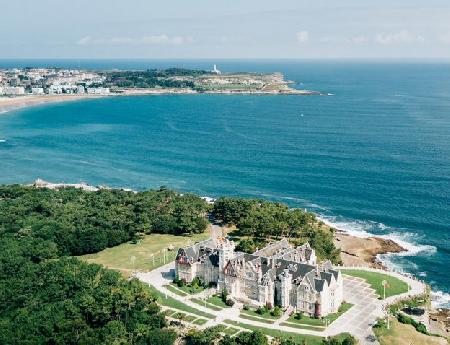Santander
 The city of Santander (Spain) is the administrative center of the Cantabria region, located in the north of the country. Santander is located next to the Atlantic Ocean, on the coast of the Bay of Biscay, and like most coastal cities, it stretches along the coast.
The city of Santander (Spain) is the administrative center of the Cantabria region, located in the north of the country. Santander is located next to the Atlantic Ocean, on the coast of the Bay of Biscay, and like most coastal cities, it stretches along the coast.
The city has a fairly long and rich history: the first mention of it dates from 1068 (under King Sancho II the Strong), and the year of its foundation is 1755. The streets of the city are mixed with old marble buildings. white and new modern buildings, while historical palaces rise between areas with urban landscapes. These architectural contrasts are quite understandable: in 1941 all the wooden buildings in the historic part of the city were completely destroyed by fire, and in 1941-1950 this area was rebuilt.
The modern Santander, with an area of 35 km² and 180,000 inhabitants, is an important port in Spain with a well-developed infrastructure. Since the beginning of the 20th century, thanks to the fact that the royal family began to come here to rest, this city has become a very fashionable tourist center. Now it can't be said to be very popular, but it still attracts many tourists from all over the world, drawn by the beautiful nature, clean beaches and attractions.
First Sardinero Beach:
The First Playa del Sardinero is not only a beach, but a historical landmark belonging to the "golden age" of this tourist complex. The area was the place where all the aristocrats and famous Spaniards met to relax in the waters.
The Primera Playa del Sardinero stretches for almost 3 km, along which there is a beautiful promenade and various gardens and parks. Even when it is not hot and you do not want to sunbathe and swim, you can walk and admire the seascape or enjoy food in one of the many cafes. The location is very convenient, close to a public transport stop and a parking lot.
Camel Beach:
A small and great beach, located in the bay in front of the entrance to the Magdalena peninsula and almost connected to Sardinero.
Santander Casino in Spain:
The El Sardinero beach area in Spanish Santander has gradually become a tourist center, with hotels, restaurants and gambling dens. To this day, the largest casino in Cantabria remains El Gran Casino Sardinero, which opened in 1916 in Piazza Italia. The modernist building, built by the architect Elo Martínez del Valle, not only played roulette, but also danced and staged musicals and opera shows. During the Franco dictatorship, this emblematic place in Santander housed a cinema. And after the restoration of the monarchy, the Gran Casino Sardinero returned to its previous state.
Magdalena Palace:
The monarchs loved Santander in Spain and made it a summer residence. By order of King Alfonso XIII, a palace of the same name was erected on the Magdalena Peninsula in 1912. The eclectic building is reminiscent of similar buildings in Queen Victoria's England. After the 1931 revolution, it was handed over to the University. Today the palace park has three caravels and a mini-zoo with seals, sea lions, and penguins. The peninsula offers a magnificent view of the Cabo Mayor Lighthouse lighthouse, built in 1839. It is home to an art museum. And the lighthouse itself is one of the main attributes of all Santander postcard photos.
Festival Palace of Cantabria:
For long walks, tourists not only have the La Magdalena peninsula, but also many kilometers of Santander dock in Spain. The Cantabria Palace of Festivals is also worth a visit. Built in 1990, the Santander site remains controversial. To some inhabitants of the kingdom of the Palace of Festivals of Cantabria it reminds them of a dog lying on top with its paws. Others are overwhelmed by the giant size and the lack of natural light inside the building. Others are puzzled by the strange passage to the flower bed under the stage and the lack of space between the rows of chairs.
Cantabria Maritime Museum:
The Maritime Museum is located between Cabo San Martín and Los Peligros beach in the bay and offers magnificent views. When you approach the museum, you will once again realize how important the sea is to Santander, because without it, the city would hardly have become a reality.

